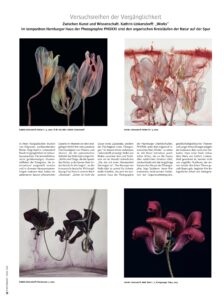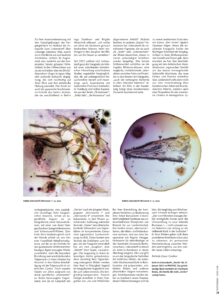[PLEASE SCROLL DOWN FOR ENGLISH VERSION]

Exploring the Ephemeral
Crossing the boundaries between art and science: Kathrin Linkersdorff’s Works at the Temporary House of Photography, PHOXXI, in Hamburg trace the organic cycles of nature
In her photographic studies of intricate, delicately luminous blossoms, Kathrin Linkersdorff captures floral evanescence in a state of suspension. The photographer’s ethereal, mostly large-format still lifes, which have been internationally exhibited and are included in various museum collections, record the ephemeral traces of plant life at the moment just before its ultimate decay: a paradoxical simultaneousness of presence and absence, which recalls the East Asian aesthetic of wabi-sabi. As the Korean-German philosopher Byung-Chul Han states in his book Absence, “Beautiful are things that carry the traces of nothingness, even of their own end in themselves. What is beautiful is not the duration of a condition […] but the fleetingness of a transition.”1
In this sense, Linkersdorff’s elegant images of flowers that oscillate between presence and absence represent a fluid “‘there’ that is coated with an absence.”2 The concept of wabi-sabi is central to Linkersdorff’s work, which is now being shown at the Temporary House of Photography, PHOXXI, Deichtorhallen Hamburg, under the deceptively laconic title Works. With this intense, poetic exhibition, which touches upon the essence of all natural existence, Ingo Taubhorn is concluding his tenure as the long-time curator of the House of Photography. His presentations of seminal positions of contemporary photography, socio- political themes, and recent developments defined the institution over the past two decades. It is no coincidence that his final project is dedicated to Kathrin Linkersdorff’s work: Taubhorn, who has consistently given space to subtle undertones in photography, has been accompanying the artist’s work from the very beginning.
Linkersdorff did not directly embark on her exploration of the manifestations of transience in the medium of photography. Born in 1966, she grew up in East Berlin and studied architecture, initially focusing her attention on the constructive terrain of built reality. In the 1990s, she worked as an architect for a longer period of time in Japan on a DAAD grant: a profound cultural encounter that had a lasting effect on her aesthetic stance and mindset. Here, she also became acquainted with the Japanese ink painting technique of Sumi-e, which she subsequently continued to practice in Berlin, an additional foundation of her photographic approach.
She already began to take photographs in her youth, primarily images of nature, with a reflex camera given to her by her father, using black and white film. At the end of her studies, shortly after the German reunification, she received a Hasselblad medium format camera from him, to which she ascribes her preference for the square format of her current, digitally produced works. The special affinity to the recurrent tulip motif in her works, in turn, has its roots in her early interest in the cultivation of tulips in her father’s garden. And yet tulips became her favored subjects primarily due to their specific “materiality,” as she has outlined in a conversation with Ingo Taubhorn and Brigitte Woischnik: “Above all, I wanted to be able to more precisely observe the texture, to delve more deeply into the ‘construction plan’ of the blossoms, to better comprehend it.”
Since 2012, Linkersdorff has been devoting herself entirely to photography as a vehicle of ongoing artistic research into the various stages of vegetal evanescence, which is based on extensive experiments and most recently also includes investigations of bacterial processes. In addition to works from her series Floriszenzen, Wabi-Sabi, Re-Naissance, and Fairies, the Hamburg exhibition encompasses her latest groups of works Microverse I and Microverse II. Her best-known series, Fairies, subdivided into five stages of increasing dissolution, depicts ethereal, fairy-like silhouettes of tulip blossoms in the concentrated gesture of a Japanese ink drawing. The photographer applied a technique of decoloration here that she developed to explore the “construction plan” or “skeleton” of her subjects.
The blossoms, which were dried over a long period of time in her laboratory-like studio before being carefully divested of their pigmentation, are brought back to life in the photographic moment as they float upside down in liquid: the filigree, transparent floral structures glow in her photographs like images “chafed by reality.”3 In other Fairiesvariations, Linkersdorff has reinfused the extracted pigments, which she also defines as the “soul” or “life elixir” of the blossoms, in an elaborate process. These enshroud the fragile flower structures like swirling veils of mist: a magical, revitalizing “interaction between color and form,” which, in the photographer’s words, also reveals “the hidden alchemy in all living matter.” A film in the exhibition shows this transformative dynamic in fascinating detail.
Over the course of developing the complex methods of realizing her artistic work, Linkersdorff has repeatedly consulted specialists from various disciplines ranging from botany to agriculture. Her two recent Microverse series, which unite micro- and macrocosm, grew from her collaboration with Regine Hengge, Professor of Microbiology at Humboldt University Berlin. Linkersdorff is currently integrated in her department as an artist-in- residence. Here now, the focus is on photographically capturing the chromatic effects that bacterial growth processes create in combination with prepared, depigmented blossoms and other plant substrates. Processes of decay become triggers of new existence, whose color phenomena can be directed to a certain degree, but which always follow their own inherent rules.
If the avid researcher-photographer previously gave shape and duration to the fleeting beauty of transience in her pictorial compositions, here she expands her exploration of the aesthetic manifestations of organic decay to include the ensuing bacterial growth that generates new colors and forms. Linkersdorff regards this not only as a continuation of her artistic work with biochemical means, but also as a perspective for an expanded scope of thinking in ecological cycles that can contribute to the long-term preservation of our planetary environment: “The decomposition brought about by microbes always makes the transformation into new, living biomass possible. […] it is not without reason that bacteria were the driving force of evolution from the start.” In her photographs, these productive cycles already become apparent: as a permanent interplay between becoming and disintegrating, from which fresh life again springs forth.
Belinda Grace Gardner
Kathrin Linkersdorff Works is open until January 21, 2024, at PHOXXI, Deichtorhallen Hamburg. A catalogue of the same title accompanying the exhibition will be published by Hartmann Books, which already published the artist’s series Fairies.
Notes:
1 Cf. Byung-Chul Han, Absence. On the Culture and Philosophy of the Far East, translated from German into English by Daniel Steuer (Cambridge, UK/Hoboken, NJ, USA: Polity Press, 2023), p. 34.
2 Cf. ibid.
3 Cf. Roland Barthes, Camera Lucida. Reflections on Photography, translated from French into English by Richard Howard (New York: Hill and Wang, 1981), p. 115.
[All of the artist’s quotes were translated by the author.]